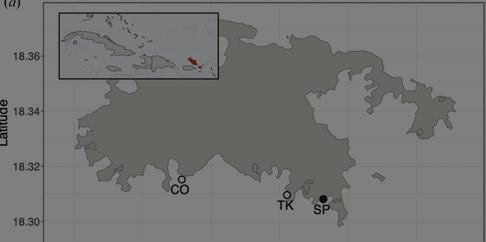
In what could prove a breakthrough, researchers have succeeded in using recorded sound to enhance the chances of coral larvae making their home on struggling coral reefs in need of new life.
With the world’s coral reef system rapidly declining, the study creates some hope that human intervention could aid restoration.
The first-time experiment was conducted in the waters off St. John’s southside in 2022 by a group of researchers from Woods Hole Oceanographic Institution. Results were published last week in Royal Society Open Science.
Woods Hole marine scientists have been actively studying St. John’s coral reefs for many years.
Corals are mobile only in their larval stage. That’s when they float through the ocean, seeking a good place to settle where they will metamorphize into the stationery animals familiar to divers and snorkelers.
They use a wide range of chemical and biophysical cues to locate favorable habitats, and some of those cues may yet to be discovered.
But, per the results of the recent study, certain sounds seem to be important.
Descriptions of the ocean as the “Silent Deep” were abandoned long ago. Rather, it is a hubbub of activity with swishing and communicating fish, snapping shrimp pulses, waves, and local weather events all contributing to the noise.
Other studies have used enhanced acoustics to draw settlement-stage fish and oyster larvae to specific areas and to accelerate the development of post-larval lobsters. There have also been studies proving that at least some species of coral larvae are sound-sensitive.
Knowing all that, the Woods Hole researchers set out to determine whether underwater sounds recorded near a thriving reef could be used to draw larvae to another reef, particularly one that is in decline. They already had the necessary recordings, which had been made over the previous 10 years.
They chose to use the coral species Porites astreoides because it is especially abundant around St. John, it is sound-sensitive, and it is hardy, that is, it withstands collection and handling well.
The researchers conducted the experiment twice in 2022, first in June and then in July, when larvae would typically be house-hunting.
They distributed the larvae near three other reefs, all of which have been studied for years: Tektite, a “high quality” reef, and Cocoloba and Salt Pond, both considered “degraded” reefs.
Then, they turned on the music selectively.

The study showed that larvae were far more likely to settle on a reef when they heard sounds that indicated it was healthy, such as noises indicating fish were present in significant numbers.
On average, larvae were almost twice as likely to settle when they heard the recordings than when they didn’t.
The recordings seemed more effective at attracting coral larvae than an actual healthy reef itself.
“We observed significantly higher rates of settlement of P. astreoides larvae at a degraded reef site with an enriched soundscape than on either high-quality or degraded natural reefs without an enriched soundscape,” the authors wrote.
Amid the good news of the study, there is also an important caveat. Finding a way to lure larvae to a degraded reef does not prove they will thrive there and ultimately contribute to the restoration of the reef. If conditions don’t support juvenile growth, the larvae won’t survive long enough to make a difference in improving the overall health of the reef.
In fact, the researchers didn’t leave the larvae on the reefs to which the study drew them, suggesting concern over that possibility. Rather, once the study was over, they returned all the coral colonies they had collected for the study to the reefs from which they had been collected.
Nevertheless, they make a case for human intervention in some form.
Coral reefs can repair themselves naturally, given enough time. But time seems to be running out. The stresses on reefs keep multiplying, especially with global warming increasing bleaching events, and Stony Coral Tissue Loss Disease devasting wide swaths of corals, and peyssonnelid algal crusts smothering reefs and muscling out corals.
“Our multipronged nature and breakneck pace of modern reef degradation will probably outstrip natural rates of ecological recovery for corals over the next century without (human) mediation,” the report says.
Authors of the study are listed as Nadѐge Aoki, Benjamin Weiss, Youenn Jézéquel, Weifeng Gordon Zhang, Amy Apprill, and T. Aran Mooney.
View the report “Soundscape enrichment increases larval settlement rates for brooding coral Porites Astreoides” here.





